

|
Hello from the Wine Tastings Guide!
This is The Poor Man's Guide to Fine Wine™, a monthly newsletter on all things wine and your guide to finding great wine at affordable prices! Each issue brings you articles about goings-ons in the world of wine as well as reviews of inexpensive wines. If you like this newsletter and our website, please forward this email to someone you know who enjoys wine or wants to learn more about wine and wine tastings. If this was forwarded to you and you like what you read, you can subscribe to The Poor Man's Guide to Fine Wine for free now. If you have suggestions, questions, article requests or comments, please contact me -- I love to hear from my readers!
Contents of this issue of |
|||||||||||||||||||||||||||||||||||||||||||||||||||||||||||||||||||||||||||||||||||||||||||||||||||||||||||||||||||||||||||||||||||||||||||||||||||||
| Zero Stars | A wine I don't particularly recommend. |
|---|---|
One Star |
Well made, simple and tasty wines that I recommend. |
Two Stars |
Excellent quality. Worth an extra effort to search out and enjoy. |
 Three Stars |
Outstanding wine of the highest caliber. |
| + Plus |
Either a wine that is close to deserving a higher score or a wine that may not be showing that much but with the potential to move up in quality with further aging. A young wine that may be closed up or shows potential for significant improvement. Assuming it opens and improves with additional age, it may merit a higher rating. |
| ??? | Flawed bottles or wines that are difficult to assess for any number of reasons. Judgement reserved. |
Sparkling Wines:
| Bele Casel Prosecco Montello e colli Asolani Spumante Extra Dry |
Drink Now-2012 | $12 | |
 Bright honeydew melon and salty chalk aromas open up the door to a fresh, vibrant Prosecco with just the barest hint of sweetness. Lively and fun, simply and refreshing. One Star. Bright honeydew melon and salty chalk aromas open up the door to a fresh, vibrant Prosecco with just the barest hint of sweetness. Lively and fun, simply and refreshing. One Star. |
|||
| Paul Berthelot a Dizy Champagne Rosé Brut |
 |
Drink Now-2025 | $50 |
| Berthelot is an excellent smaller producer from Dizy in Champagne. His excellent non-vintage Brut is an excellent value as well. The Rosé is a bit harder to find but definitely worth the search! Scrumptious sweet, but crisp ripe strawberries, chalk and intense oyster shell aromas grace this nose of this seductive Rosé. This balances the tightrope between delightfully sweet fruit yet with a chalky minerality that keeps it full, powerful and focused. I really like this. I'm not always a huge fan of Ros´ Champagne as I can find many are a bit disjointed. This one seems wonderfully poised and balanced and reminds me a bit of the Henri Billiot, one of my favorites. Two Stars Plus. |
|||
| Sorelle Bronca Particella 68 Prosecco di Valdobbiadene Extra Dry |
Drink Now-2012 | $15 | |
 A fresh, fun Prosecco but without the austerity and dryness of the really traditional examples. There is a bit more sweetness here that gives it a lusciousness, a creaminess. Its delish and a fun sparkler to start an evening. One Star Plus. A fresh, fun Prosecco but without the austerity and dryness of the really traditional examples. There is a bit more sweetness here that gives it a lusciousness, a creaminess. Its delish and a fun sparkler to start an evening. One Star Plus. |
|||
White Wines:
| Domaine Bachelet Bourgogne Aligoté 2007 |
Drink Now-2017 | $20 | |
 Bachelet is an outstanding producer of pure, seductive red Burgundies from Gevrey. However, his humble Bourgogne Aligoté white can be quite seductive too. The "lowly" Aligoté grape often maligned but this shows how good it can be in the right hands. Bachelet is an outstanding producer of pure, seductive red Burgundies from Gevrey. However, his humble Bourgogne Aligoté white can be quite seductive too. The "lowly" Aligoté grape often maligned but this shows how good it can be in the right hands.Pure and clean, fresh cut hay, stones, big white ones and pit fruits. This dry and austere wine has a fresh, vibrant personality, kinda like eating a grapefruit and chewing on the seeds. The texture has a grain to it, like salt, tannin and chalk, giving it a great palate presence and personality. Very interesting stuff. Two Stars. |
|||
| Annie et Philippe Bornard Côtes du Jura Les Chassagnes Lieu Dit Savagnin 2005 |
Drink Now-2020 | $25 | |
 I'm a big fan of oxidative-styled Jura wines, particularly those with a hefty dose of Savagnin. Their complexity and kinky aromatics is enough to make my head swoon. I was hoping for great things but was a bit disappointed with this. It started out a bit musty but that blew off. However, there was just a hint of nutty oxidation with some anise and celery seed spice but these were quite subtle and there was a complete dearth of the richer, umami notes I was hoping for. This is quite simple, even a bit dilute. It is ok, and very drinkable, it just pales in comparison to its better Côtes du Jura cousins. One Star. I'm a big fan of oxidative-styled Jura wines, particularly those with a hefty dose of Savagnin. Their complexity and kinky aromatics is enough to make my head swoon. I was hoping for great things but was a bit disappointed with this. It started out a bit musty but that blew off. However, there was just a hint of nutty oxidation with some anise and celery seed spice but these were quite subtle and there was a complete dearth of the richer, umami notes I was hoping for. This is quite simple, even a bit dilute. It is ok, and very drinkable, it just pales in comparison to its better Côtes du Jura cousins. One Star. |
|||
| Bodegas Dios Baco Amontillado | Zero Stars | Drink Now-Whenever | $24 |
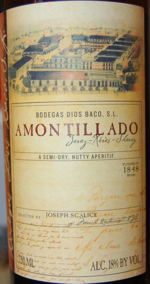 I love Sherry but I rarely buy it from Whole Foods. I needed some to cook with so I bought this. It is the most expensive Sherry Whole Foods here caries. I was hoping it would be passable. I was wrong. This is very untraditional for an Amontillado as it is quite sweet and not balanced. A good Sherry, even the sweeter ones have a vibrant acidity to it that gives them a tang and bite to keep them fresh and present on the palate. This seemed flabby and cloying. Yes, it had some nutty, rich butterscotchy aromatics that were pleasant, but overall I was very underwhelmed and didn't really want to drink it. I almost didn't use it for cooking! If you want to cook with Sherry and you have to buy at Whole Foods, stick to the cheap domestic fake "Sherry". Its better than this! Zero Stars. I love Sherry but I rarely buy it from Whole Foods. I needed some to cook with so I bought this. It is the most expensive Sherry Whole Foods here caries. I was hoping it would be passable. I was wrong. This is very untraditional for an Amontillado as it is quite sweet and not balanced. A good Sherry, even the sweeter ones have a vibrant acidity to it that gives them a tang and bite to keep them fresh and present on the palate. This seemed flabby and cloying. Yes, it had some nutty, rich butterscotchy aromatics that were pleasant, but overall I was very underwhelmed and didn't really want to drink it. I almost didn't use it for cooking! If you want to cook with Sherry and you have to buy at Whole Foods, stick to the cheap domestic fake "Sherry". Its better than this! Zero Stars. |
|||
| Dönnhoff Niederhäuser Hermannshöhle Spätlese 2008 |
 |
Drink Now-2038 | $50 |
 This barely makes the under $50 rule for the Poor Man's Guide but boy is it good! Dönnhoff is just about worth the splurge in any vintage and Hermannshöhle is often favorite vineyard. It combines complexity with a refinement and finesse that is breathtaking. This barely makes the under $50 rule for the Poor Man's Guide but boy is it good! Dönnhoff is just about worth the splurge in any vintage and Hermannshöhle is often favorite vineyard. It combines complexity with a refinement and finesse that is breathtaking.This 08 presents a loving, caressing and sexy baked apple, mint, salt flats and Champagne chalk mine-like complexity. Luscious and incredibly gulpable, yet elegant, silky and deserving of slowly savoring over hours. The texture here is one of the things that really sets it apart. It has relief, like a silky pulverized granite and chalk dust. This is long on the finish and elegant and restrained. In 08 it is not quite as big and sweet as some vintages but this is a real spä:tlese and I love it. Can you tell? Two Stars Plus. |
|||
| Bodegas Hidalgo Manzanilla La Gitana |
Drink Now-2012 | $12 | |
 Zesty, citrus and nuts, this is bright and crisp yet has an almost Alsatian waxiness to the texture with a perfumed inner mouth perfume of nuts and waxy flowers. Very pretty if a bit simple. One Star. Zesty, citrus and nuts, this is bright and crisp yet has an almost Alsatian waxiness to the texture with a perfumed inner mouth perfume of nuts and waxy flowers. Very pretty if a bit simple. One Star. |
|||
| Monte Gudello Airén Vino de la Tierra de Castilla 2006 |
Drink Now-2012 | $9 | |
 This inexpensive white from Spain is crackling with freshness, bitter grapefruit seed and pith and bright grassiness. This is almost Vinho Verde-like in its crispness and herbaceousness. The bitter ting on the finnish is perfect for washing down salty appetizers. One Star. This inexpensive white from Spain is crackling with freshness, bitter grapefruit seed and pith and bright grassiness. This is almost Vinho Verde-like in its crispness and herbaceousness. The bitter ting on the finnish is perfect for washing down salty appetizers. One Star. |
|||
| Eric Morgat Savennières L'Enclos 2006 |
Zero Stars? | Drink Now-2012 | $20 |
 I had heard good things about this relative newcomer to the ranks of Savennières. I had high hopes. This failed me. Maybe its the ripe vintage? The aromas were much more ripe than most Savs, with tropical melon and tangerine. The mouth was strange. Ripe, almost over-ripe actually with an alcoholic heat yet at the same time has an under-ripe bitter edge to the acid and a drying, awkward finish. The only thing I can think is that the grape sorting and/or harvest time poor. Seems to be the a ripe vintage with average or poor winemaking. While a great producer could pull off a compelling wine in 06, this is practically flawed. I'm willing to give Morgat another chance but based on this bottle I am far from convinced. Zero Stars? I had heard good things about this relative newcomer to the ranks of Savennières. I had high hopes. This failed me. Maybe its the ripe vintage? The aromas were much more ripe than most Savs, with tropical melon and tangerine. The mouth was strange. Ripe, almost over-ripe actually with an alcoholic heat yet at the same time has an under-ripe bitter edge to the acid and a drying, awkward finish. The only thing I can think is that the grape sorting and/or harvest time poor. Seems to be the a ripe vintage with average or poor winemaking. While a great producer could pull off a compelling wine in 06, this is practically flawed. I'm willing to give Morgat another chance but based on this bottle I am far from convinced. Zero Stars? |
|||
Red Wines:
| Bara Bouzy Rouge 2000 |
Drink Now-2030 | $50 | |
 Paul Bara is a wonderful small producer of Champagne. However, this Champagne is a bit different. Its red for one, and it doesn't have bubbles! Yes, its a dry, still red wine from Champagne. Not much of this is made anymore and is therefore somewhat of a curiosity. While you may never run into a bottle of this, I present it as just that, a curiosity that is quite unique and beautiful in its own way. You may think it would have some similarities with red Burgundy given that it is 100% Pinot Noir and you'd be right. But this Pinot Noir is grown much further north than Burgundy, in the much cooler Champange region of Bouzy. If you are looking for big, ripe, California Pinot Noir, stay far away! This is the antithesis to that! Focused, shimmering in its purity and drive, this has nothing ripe or fat about it. Instead, it shows off what Champagne does best, bright, focused acidity and vibrant minerality that run the length of the wine. This is even more lean and focused than many Burgs and therefore will have a limited audience. Some drinkers of steroid fueled, ripe wines think Burgundy is thin and dilute, they will be doubly disappointed by this. For me, this is a unique and beautiful expression of its place. Its not supposed to taste just like Burgundy, much less California or Oregon Pinot Noir. It is what it is and that is beautiful. Take it or leave it. I don't have that much experience with these but I suspect this will last a long time. I am going to hold on to my sole remaining bottle for a good many years. Any score for a wine such as this would be rather controversial but for me its at least two stars now and I could see this being three stars in several years time. Paul Bara is a wonderful small producer of Champagne. However, this Champagne is a bit different. Its red for one, and it doesn't have bubbles! Yes, its a dry, still red wine from Champagne. Not much of this is made anymore and is therefore somewhat of a curiosity. While you may never run into a bottle of this, I present it as just that, a curiosity that is quite unique and beautiful in its own way. You may think it would have some similarities with red Burgundy given that it is 100% Pinot Noir and you'd be right. But this Pinot Noir is grown much further north than Burgundy, in the much cooler Champange region of Bouzy. If you are looking for big, ripe, California Pinot Noir, stay far away! This is the antithesis to that! Focused, shimmering in its purity and drive, this has nothing ripe or fat about it. Instead, it shows off what Champagne does best, bright, focused acidity and vibrant minerality that run the length of the wine. This is even more lean and focused than many Burgs and therefore will have a limited audience. Some drinkers of steroid fueled, ripe wines think Burgundy is thin and dilute, they will be doubly disappointed by this. For me, this is a unique and beautiful expression of its place. Its not supposed to taste just like Burgundy, much less California or Oregon Pinot Noir. It is what it is and that is beautiful. Take it or leave it. I don't have that much experience with these but I suspect this will last a long time. I am going to hold on to my sole remaining bottle for a good many years. Any score for a wine such as this would be rather controversial but for me its at least two stars now and I could see this being three stars in several years time. |
|||
| Paolo Bea Montefalco Rosso 2003 |
 |
Drink Now-2023 | $40 |
 Can anyone in Europe make a balanced, complete wine in such a hot, "global warming" year like 2003? Bea can! This traditional producer in Italy is under most people's radar but is making stunning stuff. For an even better treat, try his stunning Sagrantino. Can anyone in Europe make a balanced, complete wine in such a hot, "global warming" year like 2003? Bea can! This traditional producer in Italy is under most people's radar but is making stunning stuff. For an even better treat, try his stunning Sagrantino.My immediate thoughts when sticking my nose in the glass was that this thing is alive! Like a living, organic loamy soil, rich, deep and complex with igneous rocks crushed into it. This is a passionate wine, deep and seductive. Very Italian. Yes, there is serious ripeness here but it stays perfectly balanced and focused, it just makes it more forward and seductive. There remains a great, solid core of stone, earth and meat. This is flat out great stuff! Three Stars. |
|||
| Coudoulet de Beaucastel Cotes-du-Rhone 2007 | Drink Now-2017 | $30 | |
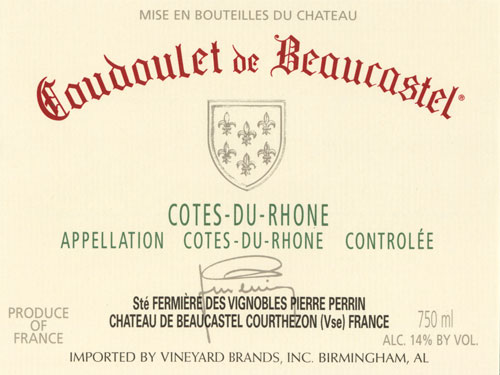 After reading this review, take a look at the Janasse CdR below. These two Cotes-du-Rhone illustrate what I like and hate about the southern Rhône. The modern style emphasizes jammy, ultra-ripe fruit that I find boring and unbalanced. Beaucastel on the other hand is very traditional. There is plenty of balance to the complex ripe fruit and in 07 is a great wine. There is an enticing earthy spice to the ripe raspberry and brambly blackberry which is young and primary but pure and beautiful. Full bodied, velvety with ample spice to the fruit and a thorny rose bush for complexity. This gets me very excited to try the Beaucastel Chateauneuf-du-Pape from 07! Two Stars. After reading this review, take a look at the Janasse CdR below. These two Cotes-du-Rhone illustrate what I like and hate about the southern Rhône. The modern style emphasizes jammy, ultra-ripe fruit that I find boring and unbalanced. Beaucastel on the other hand is very traditional. There is plenty of balance to the complex ripe fruit and in 07 is a great wine. There is an enticing earthy spice to the ripe raspberry and brambly blackberry which is young and primary but pure and beautiful. Full bodied, velvety with ample spice to the fruit and a thorny rose bush for complexity. This gets me very excited to try the Beaucastel Chateauneuf-du-Pape from 07! Two Stars. |
|||
| Giacosa Barbera d'Alba 2007 | Drink Now-2020 | $25 | |
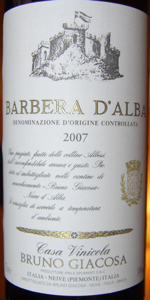 Giacosa is a brilliant traditional producer from Piedmont, one of the best in the world. While his Barolo and Barbaresco have reached stratospheric prices, the Barberas are still a relative bargain. He makes a basic Barbera as well as one from the Falletto vineyard. This is the former. Giacosa is a brilliant traditional producer from Piedmont, one of the best in the world. While his Barolo and Barbaresco have reached stratospheric prices, the Barberas are still a relative bargain. He makes a basic Barbera as well as one from the Falletto vineyard. This is the former.Jammy (in a good way, not an over-ripe, unbalanced way) berries, spicy herbs, like rosemary and savory, and a deep smokey earthiness. Rich and heady yet perfectly balanced. Ripe, juicy grape and blueberry is balanced by cranberry-like acidity. Delicious and even better with food. Two Stars. |
|||
| Domaine de la Janasse Terre d'Argile 2007 Côtes du Rhône Villages |
Drink Now-2017 | $18 | |
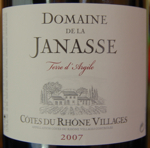 Janasse is a well respected southern Rhône producer who makes very highly rated Chateauneuf-du-Pape and 2007 is a "vintage of the century" for the region. But this wine just couldn't really convince me, primarily for stylistic reasons. I am just not down with the way the more modern producers are headed with these wines, emphasizing the ultra-ripe, jammy Grenache fruit. This wine is very ripe, jammy even. There is enough brambly, wild Provençal herbs in the aroma to remind you we are in the southern Rhône. But the flavors are decidedly modern, ripe and forward, lacking real depth and real distinction. If it is what you are looking for, this excels at ripe, fat fruit. In that respect it is quite dense and palate staining. If you just want power, fruit and modern flash, you could give this two stars. But it is barely One Star to my taste. Janasse is a well respected southern Rhône producer who makes very highly rated Chateauneuf-du-Pape and 2007 is a "vintage of the century" for the region. But this wine just couldn't really convince me, primarily for stylistic reasons. I am just not down with the way the more modern producers are headed with these wines, emphasizing the ultra-ripe, jammy Grenache fruit. This wine is very ripe, jammy even. There is enough brambly, wild Provençal herbs in the aroma to remind you we are in the southern Rhône. But the flavors are decidedly modern, ripe and forward, lacking real depth and real distinction. If it is what you are looking for, this excels at ripe, fat fruit. In that respect it is quite dense and palate staining. If you just want power, fruit and modern flash, you could give this two stars. But it is barely One Star to my taste. |
|||
| Metiusco Salento Rosso Palama 2004 |
Drink Now-2014 | $15 | |
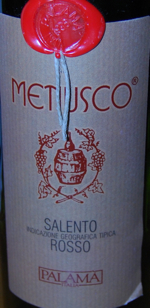 This brambly Italian red shows off aromatic herbs, oregano, grape juice and black pepper and just screams for a red pasta sauce. There is some dark fruit to the flavors but the overall sense of this is an airy and fresh red wine with lifted red fruits. Almost Chianti-like but with excellent finesse for such a cheap wine. An excellent pizza and pasta night wine. One Star Plus. This brambly Italian red shows off aromatic herbs, oregano, grape juice and black pepper and just screams for a red pasta sauce. There is some dark fruit to the flavors but the overall sense of this is an airy and fresh red wine with lifted red fruits. Almost Chianti-like but with excellent finesse for such a cheap wine. An excellent pizza and pasta night wine. One Star Plus. |
|||
| Jean-Marc & Hugues Pavelot Savigny-Les-Beaune Dominode 2007 |
Drink 2012-2022 | $40 | |
 2007 is turning out to be a very nice vintage for red Burgundy but tends to offer wines that are fruity and fresh, juicy and seductive, that seem to be better for nearer term consumption. However, Pavelot is a traditionalist producer who makes wines to age. His wines are some of the best of Savigny and the Dominode is his most famous vineyard, producing serious, dark and masculine wines. 2007 is turning out to be a very nice vintage for red Burgundy but tends to offer wines that are fruity and fresh, juicy and seductive, that seem to be better for nearer term consumption. However, Pavelot is a traditionalist producer who makes wines to age. His wines are some of the best of Savigny and the Dominode is his most famous vineyard, producing serious, dark and masculine wines.This young wine shows off a smokey and meaty personality with an almost igneous minerality. It is very young and tight, wound up and intense. It is quite dense and dark for an 07 but still has a silky, seductive texture. This really took 3 to 5 hours to really be approachable, at first burly and hard but later showing its grace and velvet texture. An excellent wine but will definitely reward extended cellaring. Two Stars. |
|||
Have a Reader Tip or a Question? Contact Me!
Looking for Wine or Wine Tasting Related Info? Search our site!
Search This Site
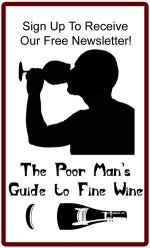
Site Sponsors

Peter Liem's
Champagne Guide

World's Best Grilling eBook!
